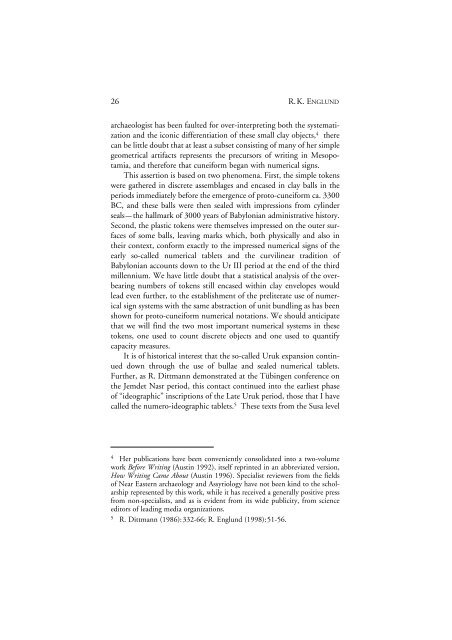PDF copy - Cuneiform Digital Library Initiative - UCLA
PDF copy - Cuneiform Digital Library Initiative - UCLA
PDF copy - Cuneiform Digital Library Initiative - UCLA
You also want an ePaper? Increase the reach of your titles
YUMPU automatically turns print PDFs into web optimized ePapers that Google loves.
26 R.K. ENGLUND<br />
archaeologist has been faulted for over-interpreting both the systematization<br />
and the iconic differentiation of these small clay objects, 4 there<br />
can be little doubt that at least a subset consisting of many of her simple<br />
geometrical artifacts represents the precursors of writing in Mesopotamia,<br />
and therefore that cuneiform began with numerical signs.<br />
This assertion is based on two phenomena. First, the simple tokens<br />
were gathered in discrete assemblages and encased in clay balls in the<br />
periods immediately before the emergence of proto-cuneiform ca. 3300<br />
BC, and these balls were then sealed with impressions from cylinder<br />
seals– the hallmark of 3000 years of Babylonian administrative history.<br />
Second, the plastic tokens were themselves impressed on the outer surfaces<br />
of some balls, leaving marks which, both physically and also in<br />
their context, conform exactly to the impressed numerical signs of the<br />
early so-called numerical tablets and the curvilinear tradition of<br />
Babylonian accounts down to the Ur III period at the end of the third<br />
millennium. We have little doubt that a statistical analysis of the overbearing<br />
numbers of tokens still encased within clay envelopes would<br />
lead even further, to the establishment of the preliterate use of numerical<br />
sign systems with the same abstraction of unit bundling as has been<br />
shown for proto-cuneiform numerical notations. We should anticipate<br />
that we will find the two most important numerical systems in these<br />
tokens, one used to count discrete objects and one used to quantify<br />
capacity measures.<br />
It is of historical interest that the so-called Uruk expansion continued<br />
down through the use of bullae and sealed numerical tablets.<br />
Further, as R. Dittmann demonstrated at the Tübingen conference on<br />
the Jemdet Nasr period, this contact continued into the earliest phase<br />
of “ideographic” inscriptions of the Late Uruk period, those that I have<br />
called the numero-ideographic tablets. 5 These texts from the Susa level<br />
4 Her publications have been conveniently consolidated into a two-volume<br />
work Before Writing (Austin 1992), itself reprinted in an abbreviated version,<br />
How Writing Came About (Austin 1996). Specialist reviewers from the fields<br />
of Near Eastern archaeology and Assyriology have not been kind to the scholarship<br />
represented by this work, while it has received a generally positive press<br />
from non-specialists, and as is evident from its wide publicity, from science<br />
editors of leading media organizations.<br />
5 R. Dittmann (1986):332-66; R. Englund (1998):51-56.
















